engine oil CHEVROLET ASTRO PASSENGER 1994 1.G Owner's Manual
[x] Cancel search | Manufacturer: CHEVROLET, Model Year: 1994, Model line: ASTRO PASSENGER, Model: CHEVROLET ASTRO PASSENGER 1994 1.GPages: 340, PDF Size: 16.86 MB
Page 260 of 340
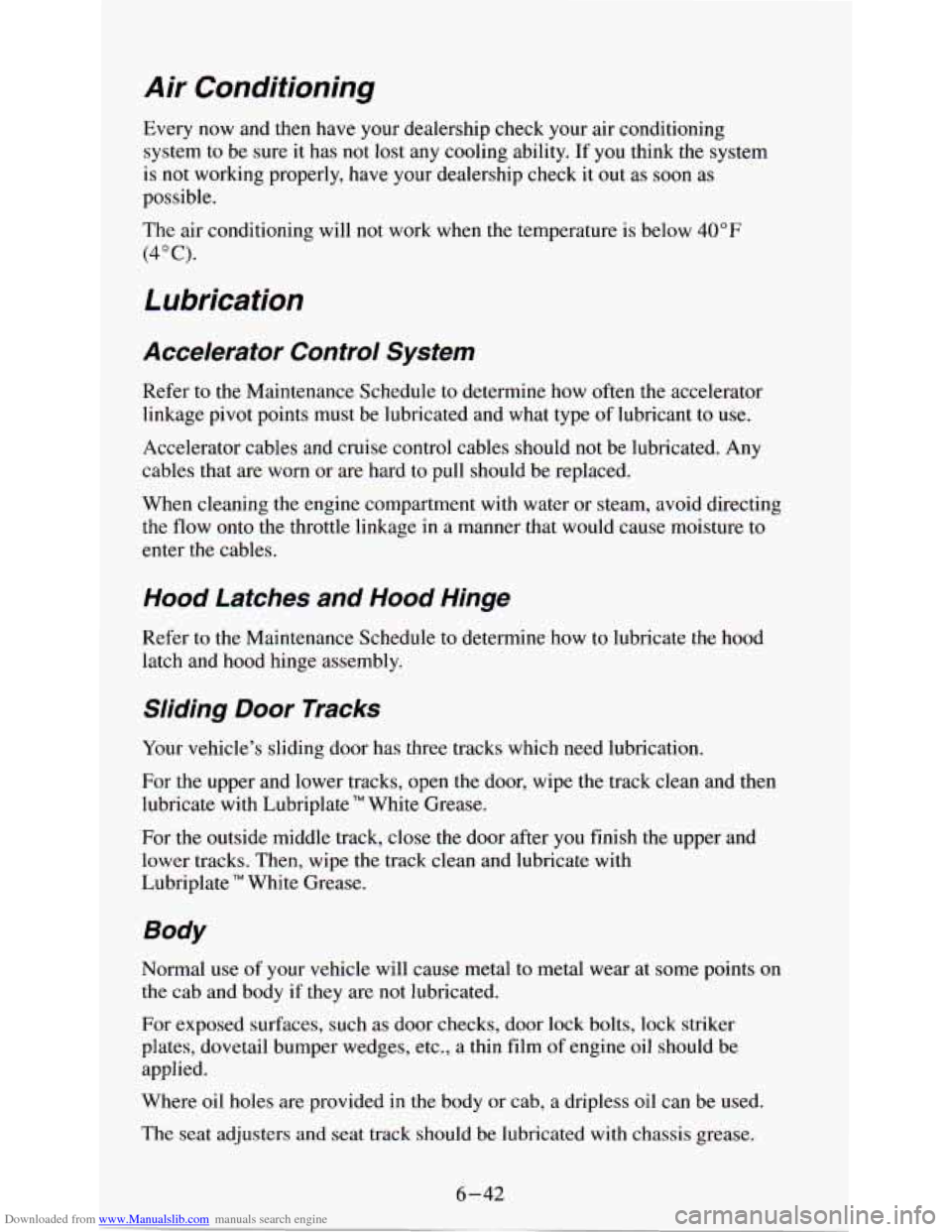
Downloaded from www.Manualslib.com manuals search engine Air Conditioning
Every now and then have your dealership check your air conditioning
system to be sure it has not
lost any cooling ability. If you think the system
is not working properly, have your dealership
check it out as soon as
possible.
The air conditioning will not work when the temperature is below
40°F
(4 O C).
Lubrication
Accelerator Control System
Refer to the Maintenance Schedule to determine how often the accelerator
linkage pivot points must be lubricated and what type of lubricant
to use.
Accelerator cables and cruise control cables should not be lubricated. Any
cables that are worn or are hard to pull should be replaced.
When cleaning the engine compartment with water or steam, avoid directing
the flow onto the throttle linkage in a manner that would cau\
se moisture
to
enter the cables.
Hood Latches and Hood Hinge
Refer to the Maintenance Schedule to determine how to lubricate the hood
latch and hood hinge assembly.
Sliding Door Tracks
Your vehicle’s sliding door has three tracks which need lubrication.
For the upper and lower tracks, open the door, wipe the track\
clean and then lubricate with Lubriplate
TM White Grease.
For the outside middle track, close
the door after you finish the upper and
lower tracks. Then, wipe
the track clean and lubricate with
Lubriplate
TM White Grease.
Body
Normal use of your vehicle will cause metal to metal wear at some points on
the cab and body
if they are not lubricated.
For exposed surfaces, such as door checks, door lock bolts, lock striker
plates, dovetail bumper wedges, etc., a thin film
of engine oil should be
applied.
Where oil holes are provided in the body or cab, a dripless oil can be used.
The seat adjusters and seat track should be lubricated with chassis grease.
6-42
Page 261 of 340
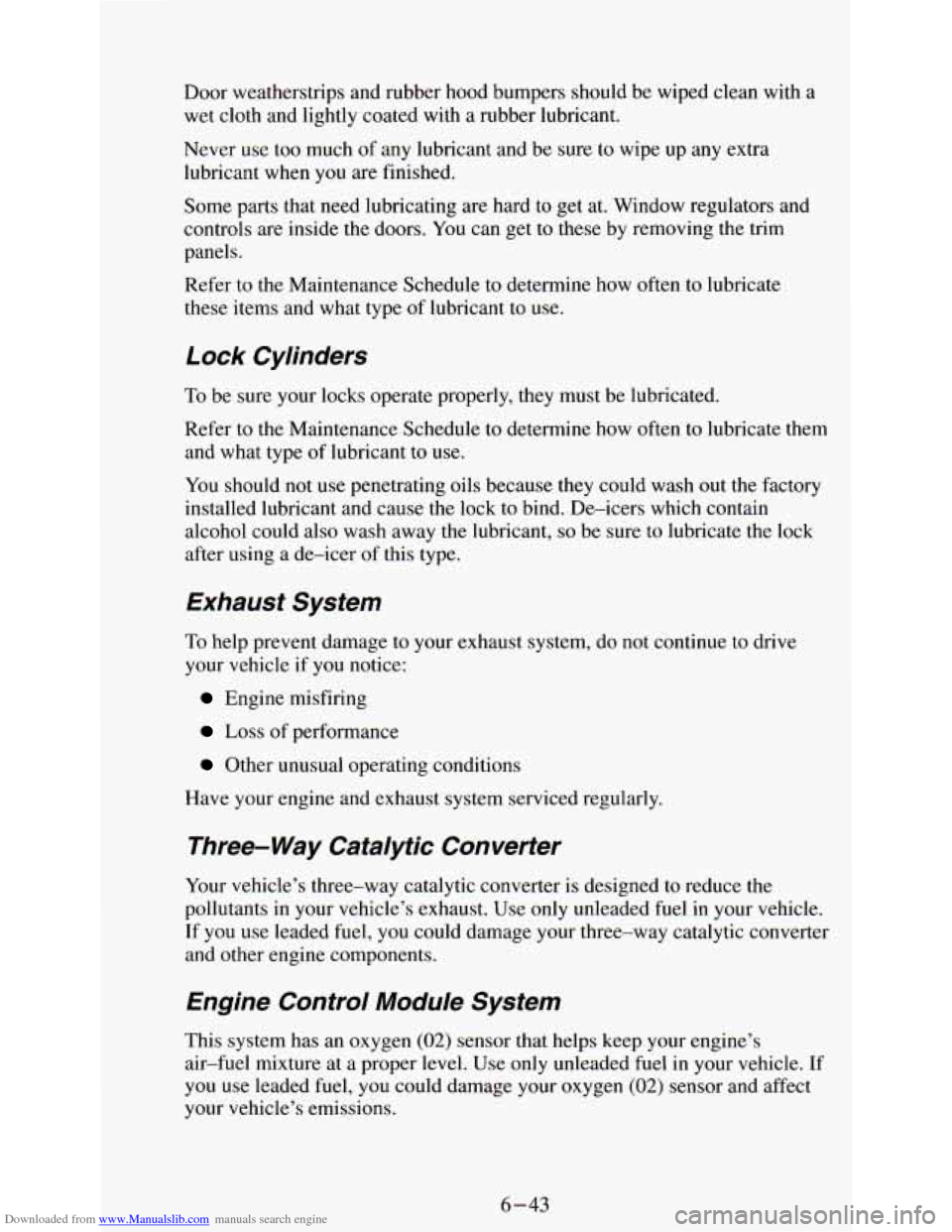
Downloaded from www.Manualslib.com manuals search engine Door weatherstrips and rubber hood bumpers should be wiped clean with a
wet cloth and lightly coated with a rubber lubricant.
Never use too much of any lubricant and be sure
to wipe up any extra
lubricant when you are finished.
Some parts
that need lubricating are hard to get at. Window regulators and
controls are inside the doors. You can get to these by removing
the trim
panels.
Refer to the Maintenance Schedule to determine how often to lubricate
these items and what type
of lubricant to use.
Lock Cylinders
To be sure your locks operate properly, they must be lubricated.
Refer to the Maintenance Schedule to determine how often to lubricate them
and what type of lubricant to use.
You should not use penetrating oils because they could wash out
the factory
installed lubricant and cause the lock to bind. De-icers which contain
alcohol could also
wash away the lubricant, so be sure to lubricate the lock
after using a de-icer of this type.
Exhaust System
To help prevent damage to your exhaust system, do not continue to drive
your vehicle if you notice:
Engine misfiring
Loss of performance
Other unusual operating conditions
Have your engine and exhaust system serviced regularly.
Three- Way Catalytic Converter
Your vehicle’s three-way catalytic converter is designed to reduce the
pollutants in your vehicle’s exhaust. Use only unleaded fuel in your vehicle.
If you use leaded fuel, you could damage your three-way catalytic converter
and other engine components.
Engine Control Module System
This system has an oxygen (02) sensor that helps keep your engine’s
air-fuel mixture at a proper level. Use only unleaded fuel in your vehicle.
If
you use leaded fuel, you could damage your oxygen (02) sensor and affect
your vehicle’s emissions.
6-43
Page 274 of 340
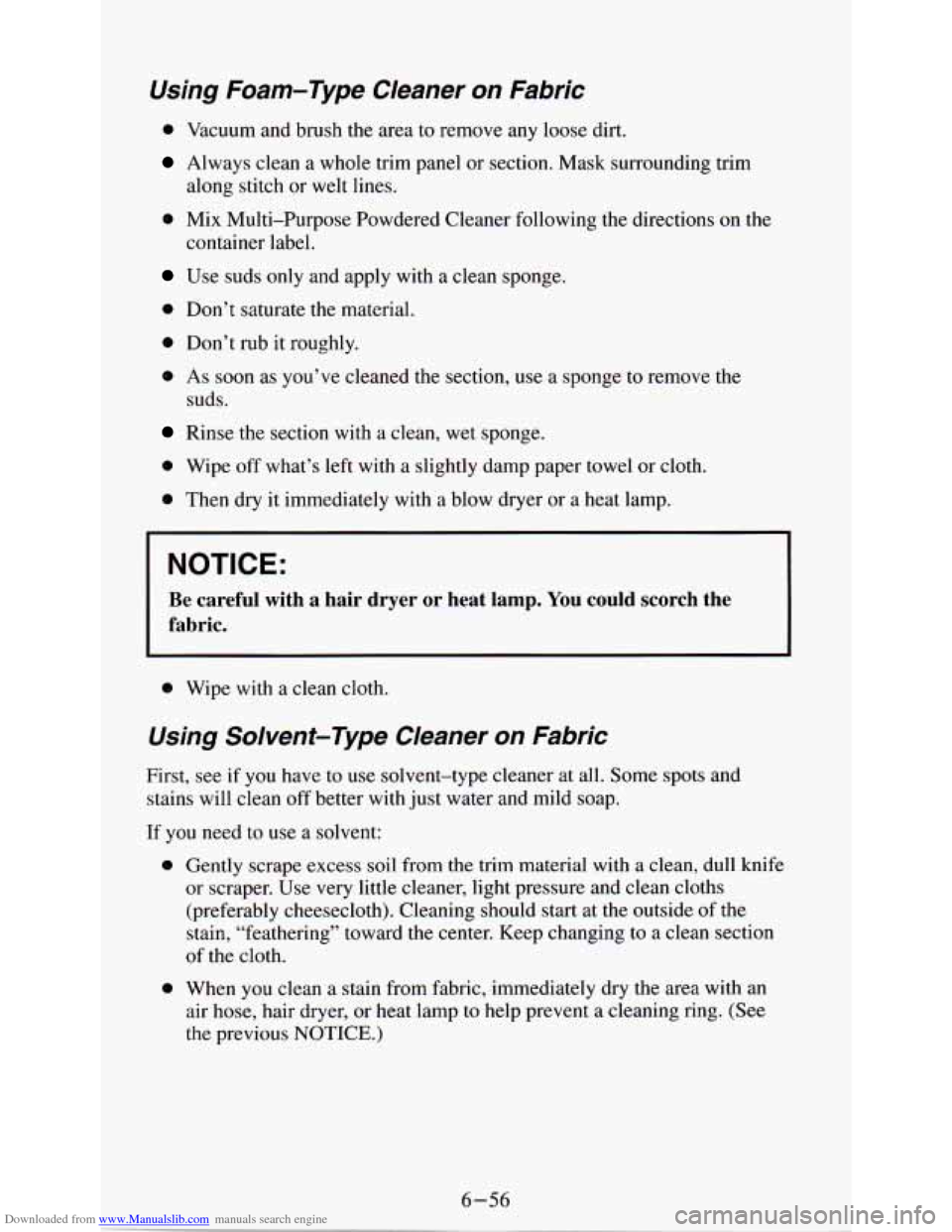
Downloaded from www.Manualslib.com manuals search engine Using Foam-Type Cleaner on Fabric
0 Vacuum and brush the area to remove any loose dirt.
Always clean a whole trim panel or section. Mask su bunding trim
0 Mix Multi-Purpose Powdered Cleaner following the directions on the
Use suds only and apply with a clean sponge.
0 Don’t saturate the material.
0 Don’t rub it roughly.
8 As soon as you’ve cleaned the section, use a sponge to remove the
Rinse the section with a clean, wet sponge.
0 Wipe off what’s left with a slightly damp paper towel or cloth.
0 Then dry it immediately with a blow dryer or a heat lamp.
along
stitch or welt lines.
container label.
suds.
NOTICE:
Be careful with a hair dryer or heat lamp. You could scorch the
fabric.
0 Wipe with a clean cloth.
Using Solvent-Type Cleaner on Fabric
First, see if you have to use solvent-type cleaner at all. Some spots and
stains will clean off better
with just water and mild soap.
If
you need to use a solvent:
0 Gently scrape excess soil from the trim material with a clean, dull knife
or scraper. Use
very little cleaner, light pressure and clean cloths
(preferably cheesecloth). Cleaning should start
at the outside of the
stain, “feathering” toward the center. Keep changing to a clean section
of the cloth.
0 When you clean a stain from fabric, immediately dry the area with an
air hose, hair dryer,
or heat lamp to help prevent a cleaning ring. (See
the previous
NOTICE.)
6-56
Page 275 of 340
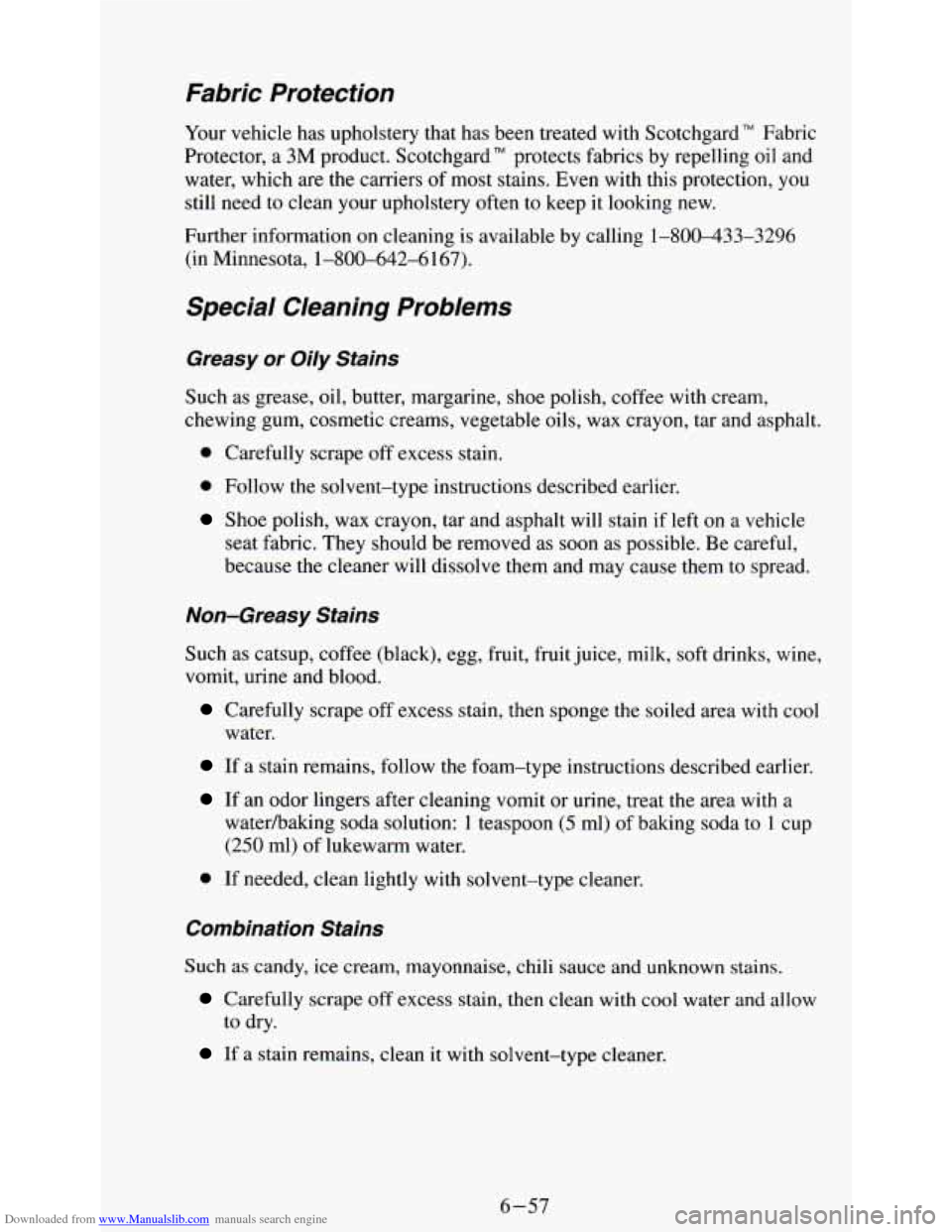
Downloaded from www.Manualslib.com manuals search engine Fabric Protection
Your vehicle has upholstery that has been treated with Scotchgard" Fabric
Protector, a 3M product. Scotchgard" protects fabrics by repelling oil and
water, which are the carriers of most stains. Even
with this protection, you
still need to clean your upholstery often to keep it looking new.
Further information on cleaning is available by calling 1-800-433-3296
(in Minnesota, 1-800-642-6 167).
Special Cleaning Problems
Greasy or Oily Stains
Such as grease, oil, butter, margarine, shoe polish, coffee with cream,
chewing gum, cosmetic creams, vegetable oils, wax crayon, tar and asphalt.
0 Carefully scrape off excess stain.
0 Follow the solvent-type instructions described earlier.
Shoe polish, wax crayon, tar and asphalt will stain if left on a vehicle
seat fabric. They should be removed as soon as possible. Be careful,
because the cleaner will dissolve them and may causf
1 to spread.
Non-Greasy Stains
Such as catsup, coffee (black), egg, fruit, fruit juice, milk, soft drinks, wine,
vomit, urine and blood.
Carefully scrape off excess stain, then sponge the soiled area with cool
water.
If a stain remains, follow the foam-type instructions described earlier.
If an odor lingers after cleaning vomit or urine, treat the area with a
waterhaking soda solution:
1 teaspoon (5 ml) of baking soda to 1 cup
(250 ml) of lukewarm water.
0 If needed, clean lightly with solvent-type cleaner.
Combination Stains
Such as candy, ice cream, mayonnaise, chili sauce and unknown stains.
Carefully scrape off excess stain, then clean with cool water and allow
to dry.
If a stain remains, clean it with solvent-type cleaner.
6-57
Page 278 of 340
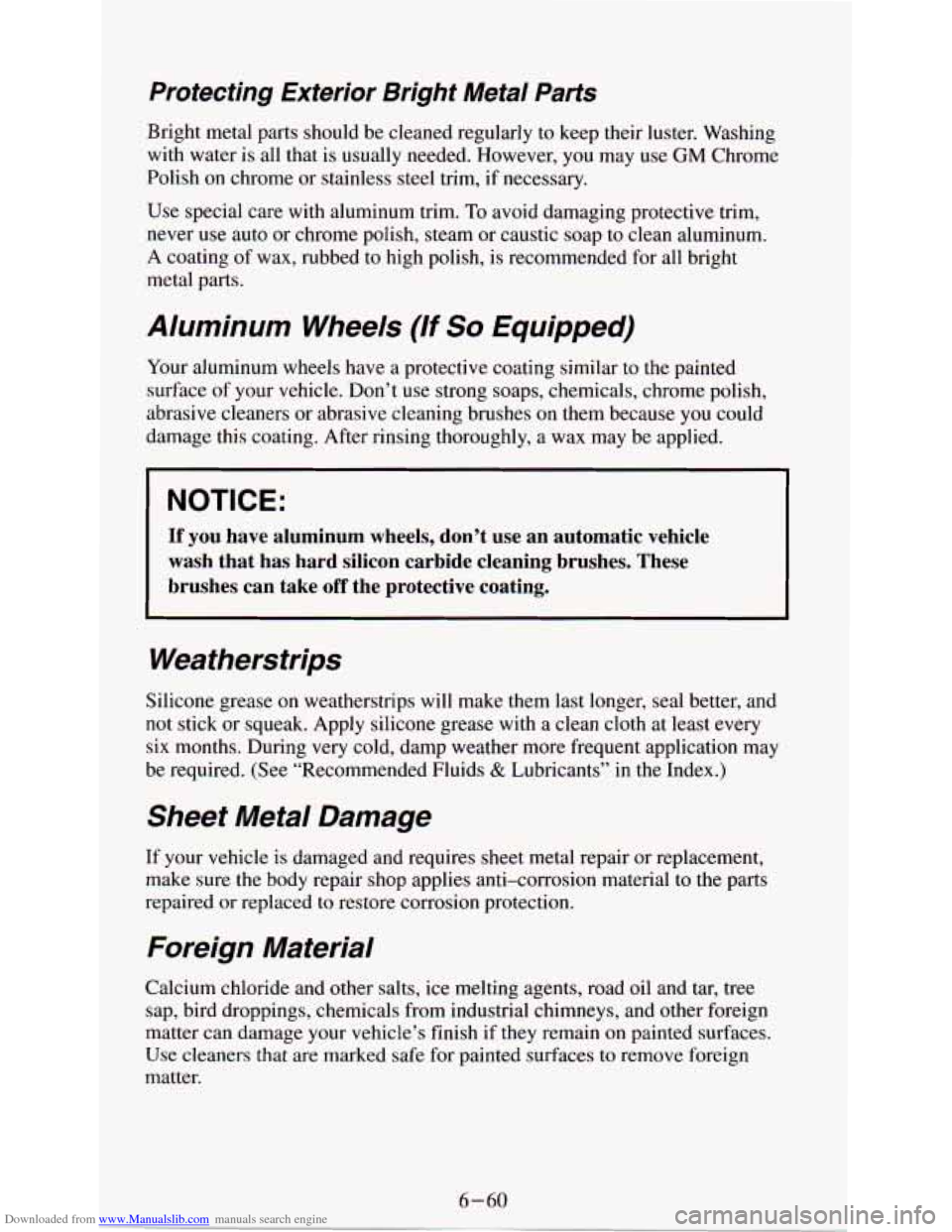
Downloaded from www.Manualslib.com manuals search engine Protecting Exterior Bright Metal Parts
Bright metal parts should be cleaned regularly to keep their luster. Washing
with water is all that is usually needed. However, you may use
GM Chrome
Polish on chrome or stainless steel trim, if necessary.
Use special care
with aluminum trim. To avoid damaging protective trim,
never use auto or chrome polish, steam or caustic soap to clean aluminum.
A coating of wax, rubbed to high polish, is recommended for all bright
metal parts.
Aluminum Wheels (If So Equipped)
Your aluminum wheels have a protective coating similar to the painted
surface
of your vehicle. Don’t use strong soaps, chemicals, chrome polish,
abrasive cleaners or abrasive cleaning brushes on them because you could
damage this coating. After rinsing thoroughly, a wax may be applied.
NOTICE:
If you have aluminum wheels, don’t use an automatic vehicle
wash that has hard silicon carbide cleaning brushes. These
brushes can take
off the protective coating.
Weatherstrips
Silicone grease on weatherstrips will make them last longer, seal better, and
not stick or squeak. Apply silicone grease
with a clean cloth at least every
six months. During very cold, damp weather more frequent application may
be required. (See “Recommended Fluids
& Lubricants” in the Index.)
Sheet Metal Damage
If your vehicle is damaged and requires sheet metal repair or replacement,
make sure the body repair shop applies anti-corrosion material to
the parts
repaired or replaced to restore corrosion protection.
Foreign Material
Calcium chloride and other salts, ice melting agents, road oil and tar, tree
sap, bird droppings, chemicals from industrial chimneys, and other foreign
matter can damage your vehicle’s finish
if they remain on painted surfaces.
Use cleaners
that are marked safe for painted surfaces to remove foreign
matter.
Page 280 of 340
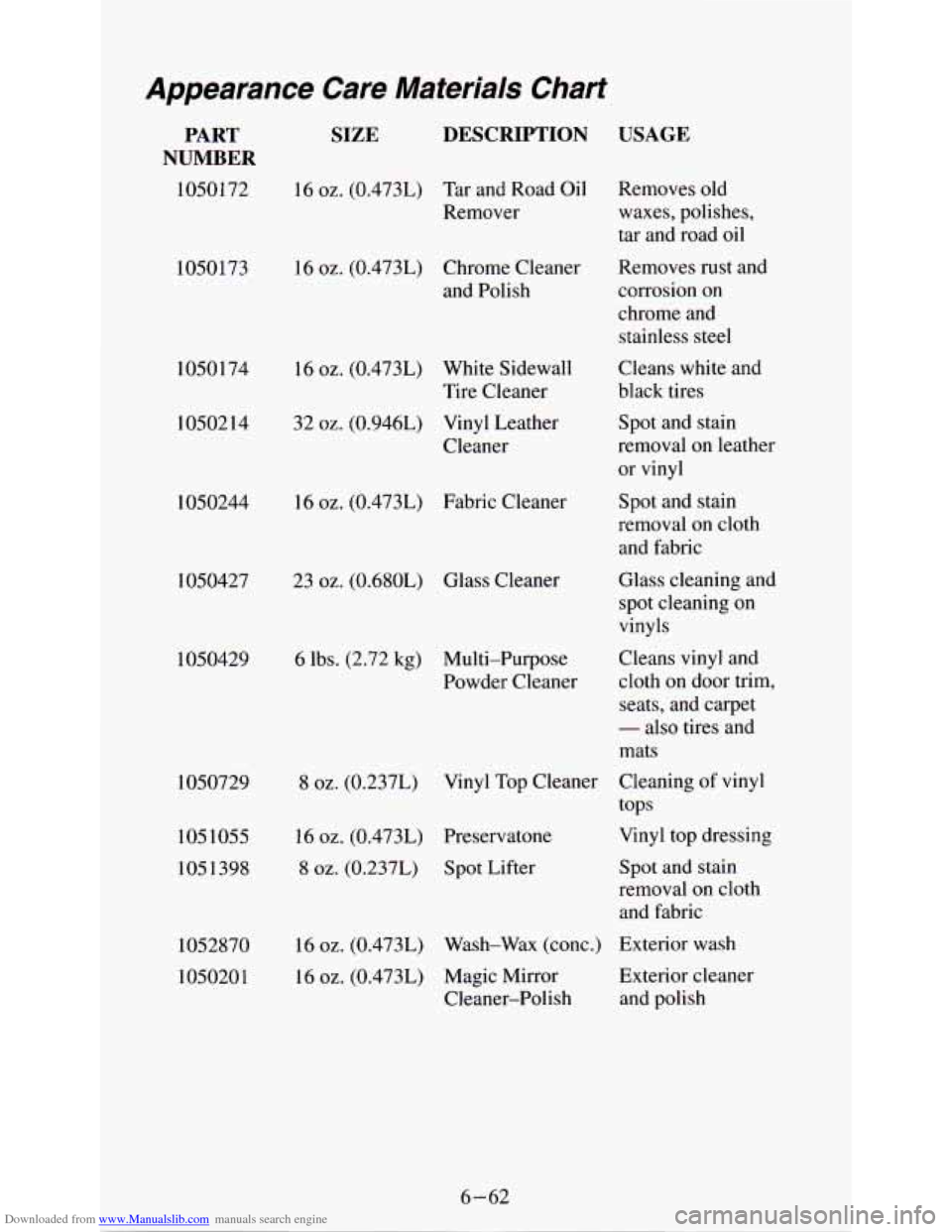
Downloaded from www.Manualslib.com manuals search engine Appearance Care Materials Chart
PART
NUMBER
1050172
SIZE DESCRIPTION USAGE
16 oz. (0.473L) Tar and Road Oil Removes old
Remover waxes, polishes,
tar and road oil
Removes rust and
1050173 16
oz. (0.473L) Chrome
Cleaner
and Polish corrosion on
chrome
and
stainless steel
16
oz. (0.473L) White Sidewall
Tire Cleaner Cleans
white and
black tires
1050174
1050214
32
oz. (0.946L) Vinyl
Leather
Cleaner Spot and stain
removal on leather
or
vinyl
1050244 16 oz. (0.473L)
Fabric Cleaner Spot
and stain
removal on cloth
and fabric
Glass cleaning and
spot cleaning on
vinyls
23
oz. (0.680L)
Glass Cleaner
1050427
1050429
6 lbs. (2.72 kg) Multi-Purpose
Powder
Cleaner Cleans vinyl and
cloth on
door trim,
seats, and carpet
- also tires and
mats
Vinyl Top Cleaner Cleaning of vinyl
tops
1050729
8 oz. (0.237L)
1051055
105
1398
16 oz. (0.473L) Preservatone
8 oz. (0.237L) Spot Lifter Vinyl top dressing Spot and stain
removal on cloth
and fabric
16
oz. (0.473L) Wash-Wax (conc.) Exterior wash
1052870
1050201 16
oz. (0.473L)
Magic Mirror
Cleaner-Polish Exterior cleaner
and polish
6-62
Page 292 of 340
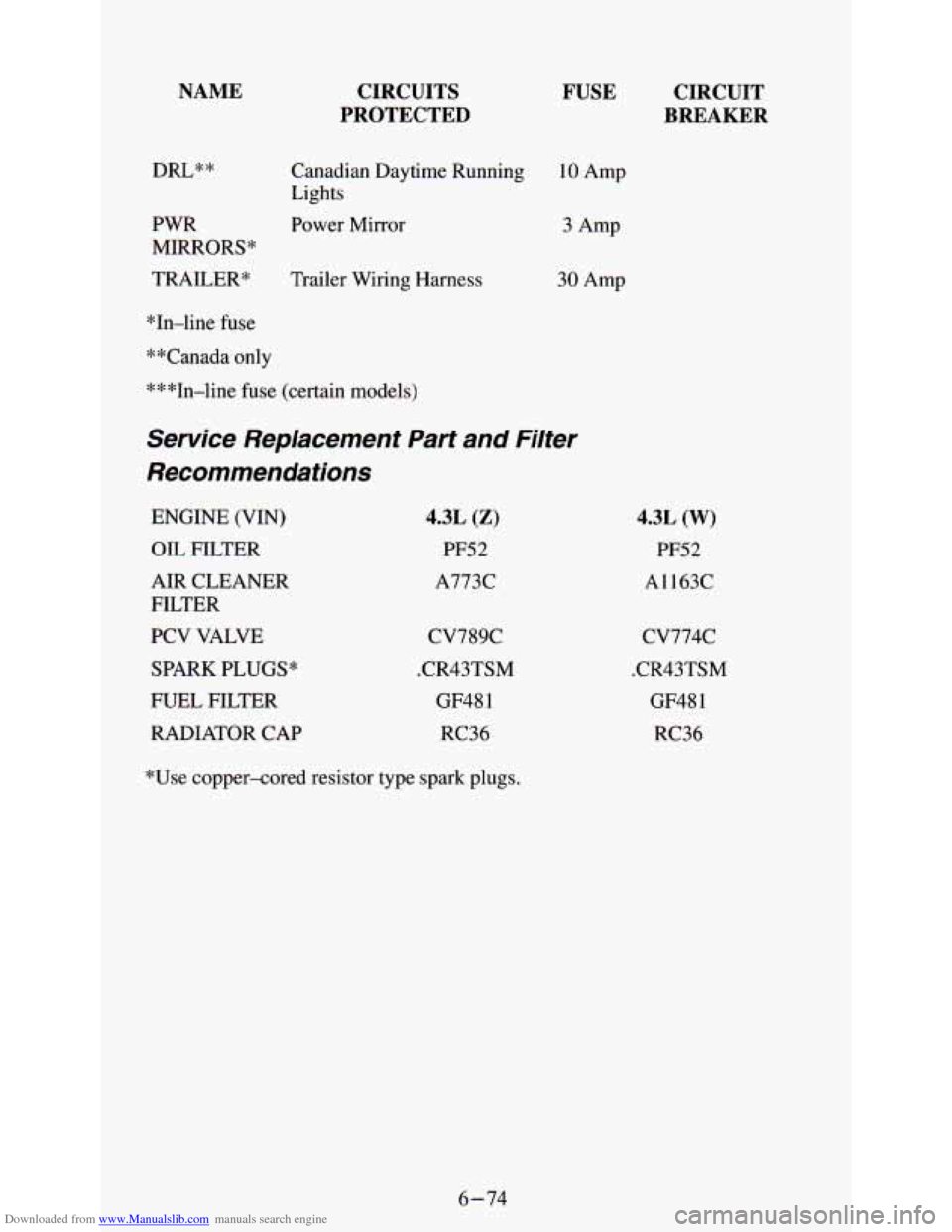
Downloaded from www.Manualslib.com manuals search engine NAME
DRL**
PWR
MIRRORS*
TRAILER*
CIRCUITS
PROTECTED
Canadian Daytime Running
Lights
Power Mirror
Trailer Wiring Harness
FUSE
10 Amp
3 Amp
30 Amp
*In-line fuse
**Canada only
***In-line fuse (certain models)
Service Replacement Part and Filter
Recommendations
ENGINE (VIN)
OIL FILTER
AIR CLEANER FILTER
PCV VALVE
SPARK PLUGS*
FUEL FILTER
RADIATOR CAP 4.3L (2)
PF52
A773C
CV789C
.CR43TSM
GF48
1
RC36
*Use copper-cored resistor type spark plugs.
CIRCUIT
BREAKER
4.3L
(W)
PF52
A1163C
cv774c
.CR43TSM GF48
1
RC36
6-74
Page 293 of 340
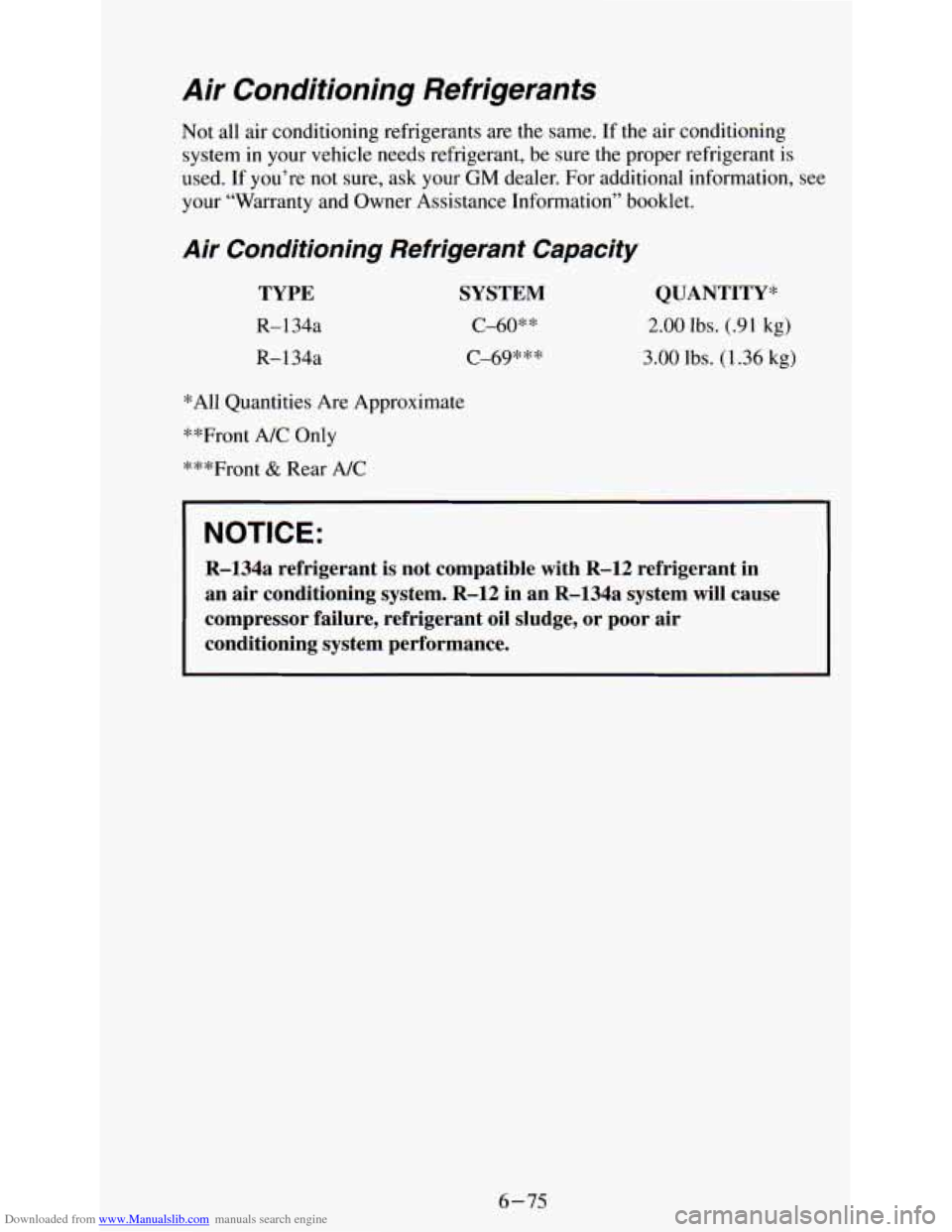
Downloaded from www.Manualslib.com manuals search engine Air Conditioning Refrigerants
Not all air conditioning refrigerants are the same. If the air conditioning
system in your vehicle needs refrigerant, be sure the proper refrigerant is
used. If you’re not sure, ask your
GM dealer. For additional information, see
your “Warranty and Owner Assistance Information” booklet.
Air Conditioning Refrigerant Capacity
TYPE
R-l34a
R-
1 34a
SYSTEM
C-60**
C-69***
*All Quantities Are Approximate
**Front A/C Only
***Front
& Rear A/C
QUANTITY*
2.00 lbs. (.91 kg)
3.00 lbs. (1.36 kg)
~~ ~.
NOTICE:
R-134a refrigerant is not compatible with R-12 refrigerant in
an air conditioning system. R-12 in an R-134a system
will cause
compressor failure, refrigerant oil sludge, or poor air conditioning system performance.
6-75
Page 300 of 340
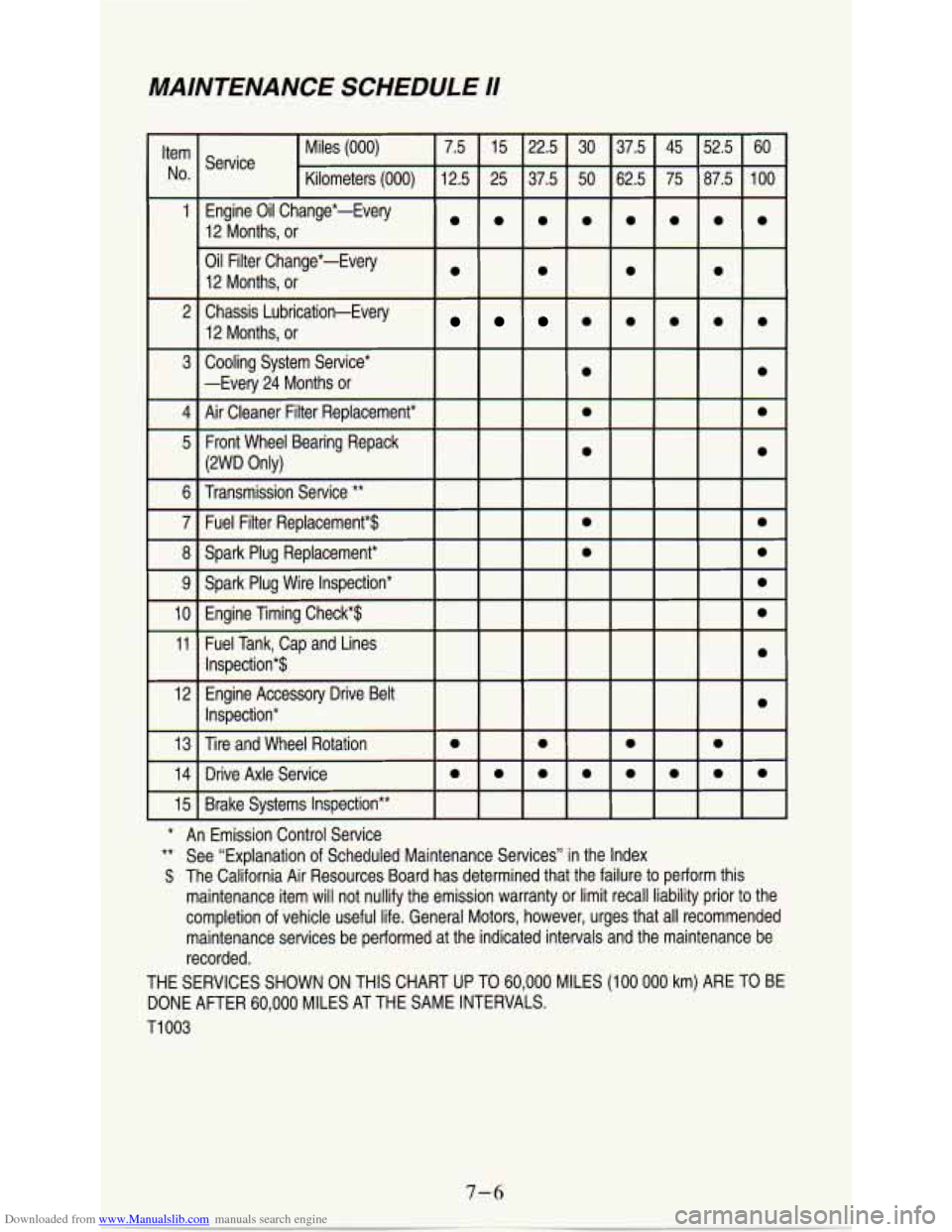
Downloaded from www.Manualslib.com manuals search engine MAlNTENANCE SCHEDULE I/
Item Miles (000) 7.5 15 22.5 30
No. Kilometers (000) 12.5 25 37.5 50
Service
Oil Filter Change*- 12 Months, or
1 12 Months, or I 1 1 I
2 Chassis Lubrication-Every
3 Cooling System Service*
-Every
24 Months or
4 I Air Cleaner Filter Replacement* I I I I 0
5 Front Wheel Bearing Repack
(2WD Only) 0
6 Transmission Service **
7 Fuel Filter Replacement*$ 0
8 Spark Plug Replacement* 0
9 Spark Plug Wire Inspection*
10 Engine Timing Check*$
11 Fuel Tank, Cap and Lines
12 Engine Accessory Drive Belt
13 Tire and Wheel Rotation
0 0
14 Drive Axle Service 0.00
15 Brake Systems Inspection** Inspection*$
Inspection”
* An Emission Control Service
** See “Explanation of Scheduled Maintenance Services” in the Index
$ The California Air Resources Board has determined that the fail\
ure to perform this
maintenance item will not nullify the emission warranty or limi\
t recall liability prior
to the
completion
of vehicle useful life. General Motors, however, urges that all recommended
maintenance services be performed at the indicated intervals and\
the maintenance be
recorded.
THE SERVICES SHOWN
ON THIS CHART UP TO 60,000 MILES (100 000 km) ARE TO BE
DONE AFTER
60,000 MILES AT THE SAME INTERVALS.
TI 003
7-6
Page 301 of 340
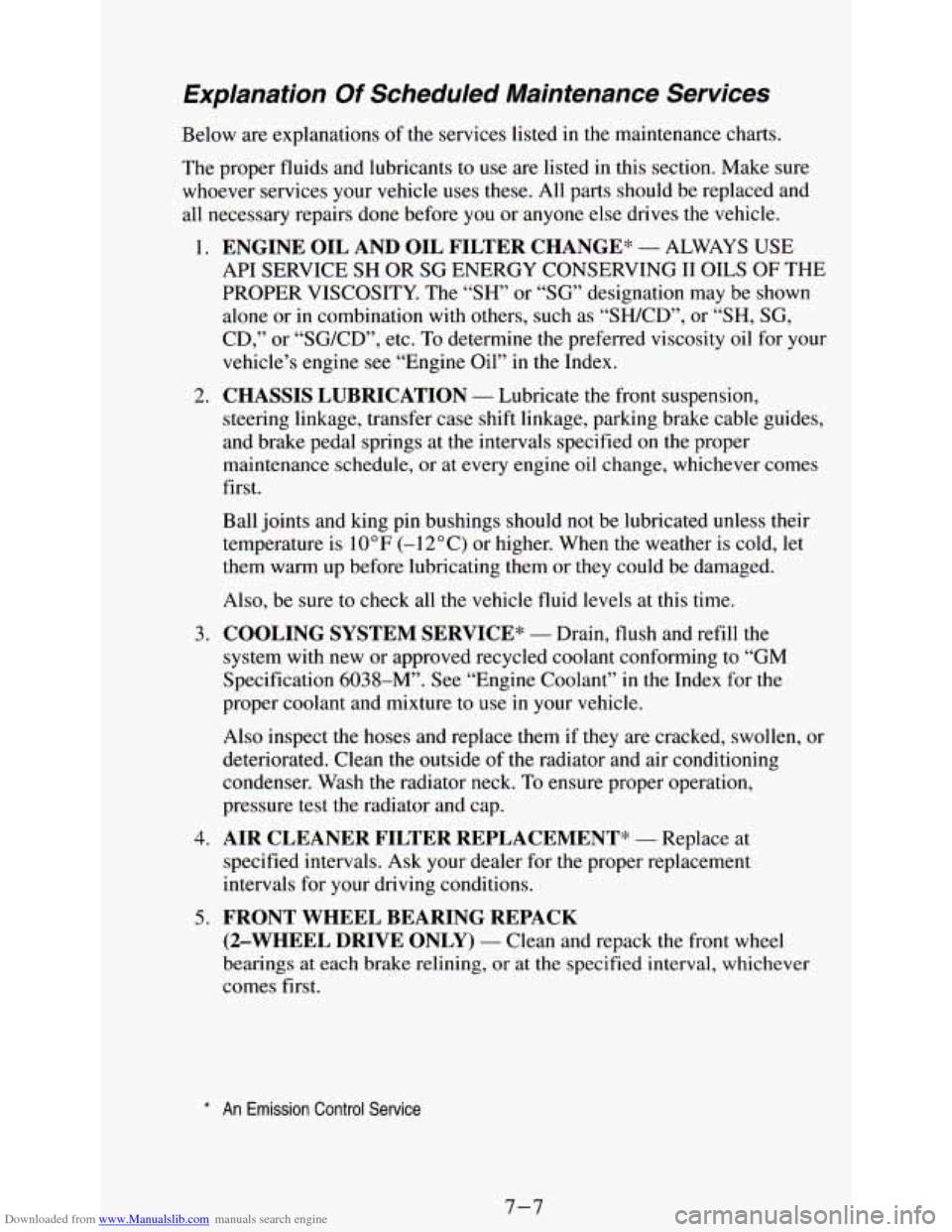
Downloaded from www.Manualslib.com manuals search engine Explanation Of Scheduled Maintenance Services
Below are explanations of the services listed in the maintenance charts.
The proper fluids and lubricants to use are listed
in this section. Make sure
whoever services your vehicle uses these. All parts should
be replaced and
all necessary repairs done before you or anyone else drives the vehicle.
1.
2.
3.
4.
5.
ENGINE OIL AND OIL FILTER CHANGE“ - ALWAYS USE
API SERVICE
SH OR SG ENERGY CONSERVING I1 OILS OF THE
PROPER VISCOSITY. The
“SH7 or “SG7 designation may be shown
alone or in combination with others, such as “SWCD”, or
“SH, SG,
CD,” or “SG/CD”, etc. To determine the preferred viscosity oil for your
vehicle’s engine see “Engine Oil”
in the Index.
CHASSIS LUBRICATION - Lubricate the front suspension,
steering linkage, transfer case shift linkage, parking brake cab\
le guides,
and brake pedal springs at the intervals specified on the proper
maintenance schedule, or at every engine oil change, whichever \
comes
first.
Ball joints and king pin bushings should not be lubricated unless their
temperature is
10°F (-1 2°C) or higher. When the weather is cold, let
them warm up before lubricating them or they could be damaged.\
Also, be sure to check all the vehicle fluid levels at this \
time.
COOLING SYSTEM SERVICE* - Drain, flush and refill the
system
with new or approved recycled coolant conforming to “GM
Specification 6038-M”. See “Engine Coolant”
in the Index for the
proper coolant and mixture to use
in your vehicle.
Also inspect the hoses and replace them
if they are cracked, swollen, or
deteriorated. Clean the outside of the radiator and air conditioning
condenser. Wash the radiator neck.
To ensure proper operation,
pressure test the radiator and cap.
AIR CLEANER FILTER REPLACEMENT* - Replace at
specified intervals. Ask your dealer for the proper replacement
intervals for your driving conditions.
FRONT WHEEL BEARING REPACK
(2-WHEEL DRIVE ONLY)
- Clean and repack the front wheel
bearings at each brake relining,
or at the specified interval, whichever
comes first.
* An Emission Control Service
7-7